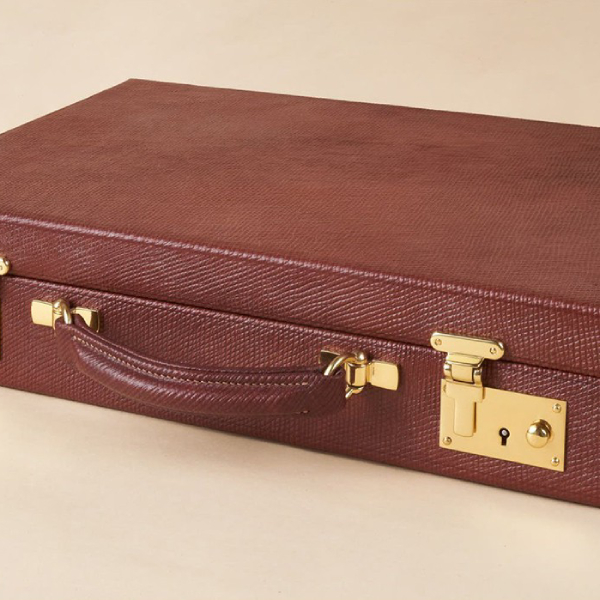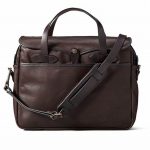Introduction: A Brief Overview
When it comes to carrying your important documents and essentials, the choice often falls between an attache case vs briefcase. While both are popular, it’s essential to understand the distinctions to make an informed decision. The attache case and the briefcase not only have unique origins but serve different functions based on their design and features.
The term ‘attache case’ has its roots in diplomatic circles, signifying a sleek and formal style, whereas ‘briefcase’ originated from legal professions and evokes a sense of robust functionality. Though there’s a common belief that they serve the same purpose, a closer look reveals some key differences.

In this blog, we’ll explore the historical background, physical characteristics, practical uses, and style considerations of both cases. Whether you’re a seasoned professional, a style-conscious individual, or simply someone in need of a functional accessory, this guide will help you decide between an attache case and a briefcase. Stay with us as we decode the differences and help you choose the right case for your needs.
Historical Background of the Attache Case and Briefcase
The attache case boasts a diplomatic origin, with the word ‘attache’ stemming from the French language. It refers to an administrative member of an ambassador’s staff. These diplomats would carry slender cases to house their documents; hence, the name attache case emerged.
In contrast, the briefcase has a legal background. The term ‘brief’ in legal terms means a summary of a case’s facts. Lawyers used to transport their legal documents and briefs in sturdy cases, which eventually became known as briefcases.
Over time, both the attache case and briefcase evolved beyond their original uses. Today, they carry a variety of items and serve multiple functions. Yet their historical roots still influence the design and image associated with each. The modern briefcase, while versatile in function, still reflects its historical origins in both style and practicality.
While the attache case incarnates elegance and formality, the briefcase suggests practicality and a capacity for larger content. Both cases have traversed history and adapted to the modern world while maintaining their unique traits.
Understanding this historical context adds depth to the choice between an attache case vs briefcase. As function merged with fashion, these carriers now embody both utility and a statement of personal style.
Physical Characteristics of Attache Cases
Attache cases display a slim, sleek profile, true to their diplomatic roots. Their design typically features two symmetrical compartments upon opening. The exterior is commonly made of hard materials like leather or metal, emphasizing durability and sophistication. Unlike many modern briefcases, traditional attache cases didn’t include a shoulder strap; however, contemporary models often incorporate this element for convenience. The overall design exudes professionalism and is crafted for holding documents flat, ensuring they remain crisp and presentable during transport.
The structure of an attache case mirrors its intended use: practical yet elegant, an ideal accessory for those who value formality and efficiency. Its compact nature doesn’t lend much to bulkier items, but rather serves as a flawless fit for paperwork and slim electronics like laptops. The inclusion of locks, often key or combination, secures contents and provides a sense of exclusivity and privacy. An attorney briefcase exemplifies the balance of practicality and elegance, ensuring secure storage for essential documents and slim devices during formal engagements.
In essence, the physical characteristics of an attache case speak to its legacy as a symbol of administrative grace and the discreet transport of important documents. It’s a nod to a time when the contents of such a case could sway diplomatic or business endeavors with a subtle yet undeniable impact. Each design element contributes to a narrative of importance and prestige, bundling practicality with a classic aesthetic.
Physical Characteristics of Briefcases
Briefcases are known for their flat, rectangular shape, often with a more spacious interior than attache cases. Their design allows for a single main compartment, which commonly includes organizational pockets or expandable gussets. This construction caters to professionals who require more storage capacity for their daily essentials.
Briefcases traditionally featured a sturdy handle without a shoulder strap, reflecting their roots in the legal field where they carried important documents. Over time, to accommodate the modern professional, many briefcases now come with a detachable shoulder strap for added convenience and ease of transport.
The materials used for briefcases range from leather to canvas, projecting different levels of sophistication and resilience. Leather briefcases, in particular, have surged back into fashion, bringing a sense of timeless elegance to the work environment. Their broader design compared to an attache case makes them suitable for holding more than just documents, such as laptops, chargers, and even a change of clothes for short trips.

In essence, the physical attributes of briefcases align with their function as a multi-use carrier, blending organizational features with a traditional aesthetic. They represent a balance of form and function, designed to serve the varied needs of today’s professionals while maintaining a classic look. The MP5 briefcase gun exemplifies the fusion of practicality and classic design, balancing a professional appearance with concealed functionality for today’s security needs.
Practical Uses of Attache Cases
Attache cases are ideal for carrying vital documents and sleek laptops. They are best suited for professionals who require a refined accessory for their most important papers and slim electronic devices. These cases are not just about carrying items; they ensure that documents remain flat and uncreased, projecting an image of meticulous professionalism.
Laptop Friendliness: The slim design caters perfectly to modern, thin laptops, providing a snug fit that keeps the device secure.
VIP Documents Storage: An attache case signals exclusivity, often chosen to carry sensitive documents that require a higher level of discretion.
Ease of Organization: With a two-compartment system, attache cases offer an organized way to separate and access papers and electronics.
Style Statement: Beyond functionality, attache cases enhance a professional look with their sleek and classic design, aligning with a formal business attire.
In summary, an attache case is for those who prize a combination of practicality, sleek styling, and professionalism. It’s a select choice for transporting fewer, albeit crucial, items efficiently and stylishly.
Practical Uses of Briefcases
Briefcases excel in versatility and capacity, making them a staple for professionals who need to carry a multitude of items. Let’s delve into some of their practical uses:
Ample Storage: Briefcases typically offer a single large compartment with additional pockets, ideal for carrying documents, laptops, chargers, and sometimes even a change of clothes.
Organized Compartments: Their design often includes dedicated spaces for specific items which aids in organization, reducing the time spent searching for things.
Professional Portability: A briefcase with a sturdy handle and optional shoulder strap facilitates easy transport of office essentials, from pens to paperwork.
Fashion Flexibility: Leather briefcases add a touch of class and can complement various professional attire, standing out in the sea of casual backpacks and totes.
In essence, a briefcase is not just a container; it’s a mobile desk that brings structure and efficiency to your daily business operations. It’s the go-to choice for carrying more than the essentials, making it ideal for lengthy work days or short business trips.
Fashion and Style Considerations
When picking between an attache case and a briefcase, style is key. It’s not just about capacity or usage, but also how you present yourself. Both cases offer distinct vibes that can boost your professional image.
Attache Case: Elegance and Professionalism
An attache case carries an air of formality and sleekness. Its slim design makes for a sharp accessory, portraying an organized and detail-oriented individual. Leather attache cases, in particular, state a bold fashion choice, often resonating with elite professionalism. They pair well with tailored suits and smart business attire, enhancing one’s image in high-stake environments like board meetings or executive gatherings.
Briefcase: Versatility and Sophistication
A leather briefcase, on the other hand, is versatile in style. It fits a variety of professional settings and attire, from business casual to formal. The leather’s patina can also add character, signaling a seasoned professional with a taste for quality. It’s the type that sets one apart in a corporate setting, amidst a sea of mundane carriers. For those who seek a traditional yet fashionable statement, a robust leather briefcase is unmatched. Additionally, with a palette of colors and finishes, briefcases offer a broader spectrum for personal expression.

In essence, your choice between an attache case vs briefcase transcends mere practicality. It influences the manner in which colleagues and clients perceive you. This choice becomes part of your personal branding. Go for an attache case for a refined and classic look or opt for a briefcase for versatility with a touch of elegance. The decision lies in how you wish to be seen and the statement you intend to make.
Decision Factors: Choosing Between an Attache Case and a Briefcase
Selecting the right case may seem daunting, but it revolves around personal needs and style. Here are factors to consider when choosing between an attache case and a briefcase:
- Purpose of Use: Think about your main use for the case. An attache case is ideal for carrying documents and a laptop in style. A briefcase is better if you need more space for various items.
- Capacity Requirements: Assess how much you need to carry. If you carry bulkier items or a lot of gear, a briefcase offers more room. If just a few vital items, an attache case suffices.
- Image and Style: Your case says a lot about you. Choose an attache case for a sleek, professional look. A briefcase can project a classic, versatile image.
- Travel Needs: Consider your travel frequency and duration. For overnight trips, a briefcase might be more practical. Attache cases are not meant for holding clothes and extras.
- Comfort and Portability: Prioritize your comfort. If you’re on the move a lot, a case with a shoulder strap, like many modern briefcases, may work best.
- Personal Preference: Ultimately, go with what you prefer. Whether it’s the traditional appeal of a briefcase or the elegance of an attache case, choose what aligns with your personality and needs.
In conclusion, when deciding between an attache case vs briefcase, think purpose, capacity, style, travel, and comfort. Your choice should enhance your efficiency and image in the professional world.
Conclusion: Selecting the Right Case for Your Needs
In summary, choosing between an attache case and a briefcase hinges on your unique needs and style. Reflect on the day-to-day items you carry. Lean towards an attache case for a slim, neat look with fewer items. Opt for a briefcase for more space and varied compartments. Think about how you move through your day. For those who travel or walk a lot, a briefcase with a shoulder strap may offer ease. Consider your style and how you want to be seen. An attache case speaks to sleek professionalism, while a briefcase suggests versatility and established taste.
Factor in your demands for stay or travel. A briefcase may serve you better for trips with its room for clothes and gadgets. Comfort matters too. Choose a case that feels right to carry around, without causing strain.
In the end, your choice should boost your professional life. It should fit your personal brand and make your daily routine smoother. Whether it’s an attache case or a briefcase, pick the one that aligns with your work, comfort, and image. Your case isn’t just a carrier; it’s a companion in your professional journey.

